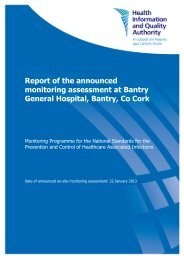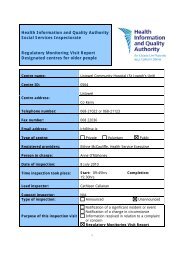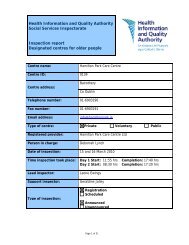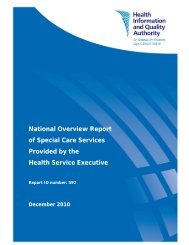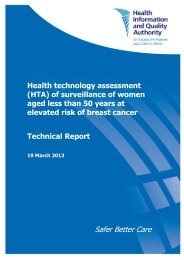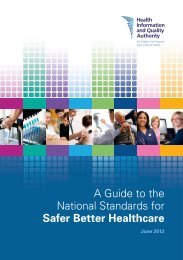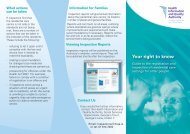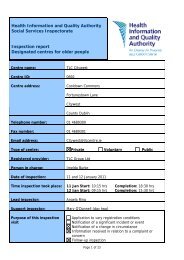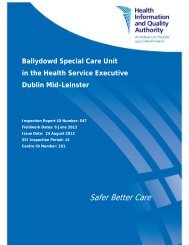Health Information and Quality Authority Social Services ... - hiqa.ie
Health Information and Quality Authority Social Services ... - hiqa.ie
Health Information and Quality Authority Social Services ... - hiqa.ie
You also want an ePaper? Increase the reach of your titles
YUMPU automatically turns print PDFs into web optimized ePapers that Google loves.
<strong>Health</strong> <strong>Information</strong> <strong>and</strong> <strong>Quality</strong> <strong>Authority</strong><br />
<strong>Social</strong> <strong>Services</strong> Inspectorate<br />
Inspection report<br />
Designated centres for older people<br />
Centre name:<br />
Riada House Community Nursing Unit<br />
Centre ID: 529<br />
Arden Road<br />
Centre address:<br />
Tullamore<br />
Co. Offaly<br />
Telephone number: 057 9359985<br />
Fax number: 057 9359986<br />
Email address:<br />
audrey.wright@hse.<strong>ie</strong><br />
Type of centre: Private Voluntary Public<br />
Registered provider:<br />
Person in charge:<br />
<strong>Health</strong> Service Executive<br />
Acting Person in Charge: Audrey Wright<br />
Date of inspection: 29 September 2009<br />
Time inspection took place: Start: 09:15 hrs Completion: 19:00 hrs<br />
Lead inspector:<br />
Support inspector(s):<br />
Type of inspection:<br />
Eileen Kelly<br />
Carol Grogan<br />
Finbarr Colfer<br />
Registration<br />
Scheduled<br />
Announced<br />
Unannounced<br />
Page 1 of 30
About inspection<br />
The purpose of inspection is to gather evidence on which to make judgments about<br />
the fitness of the registered provider <strong>and</strong> to report on the quality of the service. This<br />
is to ensure that providers are complying with the requirements <strong>and</strong> conditions of<br />
their registration <strong>and</strong> meet the st<strong>and</strong>ards; that they have systems in place to both<br />
safeguard the welfare of service users <strong>and</strong> to provide information <strong>and</strong> evidence of<br />
good <strong>and</strong> poor practice.<br />
In assessing the overall quality of the service provided, inspectors examine how well<br />
the provider has met the requirements of the <strong>Health</strong> Act 2007, the <strong>Health</strong> Act 2007<br />
(Care <strong>and</strong> Welfare of Residents in Designated Centres for Older People) Regulations<br />
2009 <strong>and</strong> the National <strong>Quality</strong> St<strong>and</strong>ards for Residential Care Settings for Older<br />
People in Irel<strong>and</strong> under the following topics:<br />
1. Governance <strong>and</strong> leadership: how well the centre is organised.<br />
2. The quality of the service.<br />
3. How well the healthcare needs of residents are met.<br />
4. Premises <strong>and</strong> equipment: appropriateness <strong>and</strong> adequacy.<br />
5. Communication: information provided to residents, relatives <strong>and</strong> staff.<br />
6. Staffing: the recruitment, supervision <strong>and</strong> competence of staff.<br />
This report summarises the findings of the inspection under some or all of these<br />
topics, highlighting areas of good practice as well as areas where improvements<br />
were required as follows:<br />
Evidence of good practice - this means that an acceptable st<strong>and</strong>ard was reached<br />
<strong>and</strong> the provider demonstrated a culture of rev<strong>ie</strong>w <strong>and</strong> improvement <strong>and</strong> aimed to<br />
drive forward best practice.<br />
Some improvements required – this means that practice was generally<br />
satisfactory but there were areas that need attention.<br />
Significant improvements required – this means that unacceptable practice was<br />
found.<br />
The report also identif<strong>ie</strong>s minor issues, where applicable, to which the provider<br />
should give consideration to enhance the quality of the service.<br />
The report is available to residents, relatives, providers of services <strong>and</strong> members of<br />
the public, <strong>and</strong> is published on our website www.<strong>hiqa</strong>.<strong>ie</strong>.<br />
Acknowledgements<br />
The inspectors wish to acknowledge the co-operation <strong>and</strong> assistance of the residents,<br />
relatives, provider <strong>and</strong> staff during the inspection.<br />
Page 2 of 30
About the centre<br />
Description of services <strong>and</strong> premises<br />
Riada House Community Nursing Unit is a purpose built single storey building<br />
providing long term care for thirty six residents with six additional places for respite<br />
care. The building has recently undergone major refurbishment <strong>and</strong> existing<br />
residents had been settling into their new rooms during the past two months. Phase<br />
two of the refurbishment project is in the planning stages <strong>and</strong> has yet to commence.<br />
This will increase bed capacity by a further twenty places within the next year.<br />
Presently, the accommodation consists of eighteen single rooms, three two-bedded<br />
rooms, four three-bedded rooms <strong>and</strong> six multi occupancy rooms for between four<br />
<strong>and</strong> nine residents. There are five single bedrooms with en suite, eight shared<br />
bedrooms with en suite, six assisted shower rooms <strong>and</strong> two assisted bathrooms.<br />
Other facilit<strong>ie</strong>s include a spacious dining room, a treatment room, two kitchenettes<br />
for making tea <strong>and</strong> coffee, an oratory, a large reception area in the front hall <strong>and</strong> a<br />
comfortable day room. This kitchen also catered for a local meals-on-wheels service<br />
as well as the day care service on site <strong>and</strong> a local mental health unit. Communal<br />
rooms <strong>and</strong> hallways lead out to two garden areas, one with a fish pond <strong>and</strong> ivy clad<br />
gazebo (used as a smoking area) <strong>and</strong> the other has a wide hazard free pathway to<br />
allow less able residents to exercise.<br />
Day-care facilit<strong>ie</strong>s are also on site <strong>and</strong> some residents from the residential centre<br />
attend on a regular basis.<br />
Location<br />
Riada Community Nursing Unit is located on the same site as the <strong>Health</strong> Service<br />
Executive (HSE) Mid Leinster offices on Arden Road. It is situated close to the town<br />
of Tullamore <strong>and</strong> is a five minute trip by car to the train station.<br />
Date centre was first established: 1979<br />
Number of residents on the date of 36 residents <strong>and</strong> 5 respite care<br />
inspection<br />
residents on the day. Total 41.<br />
Dependency level of<br />
current residents<br />
Max High Medium Low<br />
Number of residents 30 4 2 0<br />
Page 3 of 30
Management structure<br />
The provider is the <strong>Health</strong> Service Executive (HSE) <strong>and</strong> the designated contact<br />
person is Gerry Raleigh, General Manager, Laois/Offaly. Audrey Wright is presently<br />
acting as Person in Charge. The clinical nurse managers <strong>and</strong> nursing staff report to<br />
the person in charge. The care attendants are supervised by the clinical nurse<br />
managers. Household <strong>and</strong> catering staff report to the household <strong>and</strong> catering<br />
manager who in turn reports to the person in charge.<br />
Staff<br />
designation<br />
Number of<br />
staff on duty<br />
on day of<br />
inspection<br />
Person<br />
in<br />
Charge<br />
Nurses<br />
Care<br />
staff<br />
Catering<br />
staff<br />
Cleaning<br />
<strong>and</strong><br />
laundry<br />
staff<br />
Admin<br />
staff<br />
1 6 6 6 3 1.5 0<br />
Other<br />
staff<br />
Page 4 of 30
Summary of findings from this inspection<br />
This was the first inspection of this centre, it was unannounced <strong>and</strong> was carr<strong>ie</strong>d out<br />
over one day. Inspectors spoke with residents <strong>and</strong> relatives, observed the daily life<br />
<strong>and</strong> v<strong>ie</strong>wed records <strong>and</strong> documentation. There was a general meeting for staff <strong>and</strong><br />
union representatives on the day of the inspection, which went ahead without<br />
disruption to the residents.<br />
A focused <strong>and</strong> committed style of management was demonstrated by the acting<br />
person in charge. There was evidence that the person in charge was beginning to<br />
implement the requirements in the <strong>Health</strong> Act 2007, the <strong>Health</strong> Act 2007 (Care <strong>and</strong><br />
Welfare of Residents in Designated Centres for Older People) Regulations 2009 <strong>and</strong><br />
the National <strong>Quality</strong> St<strong>and</strong>ards for Residential Care Settings for Older People in<br />
Irel<strong>and</strong>.<br />
Inspectors found that the person in chare created a learning culture <strong>and</strong> continuous<br />
improvement on the quality of service for residents. High levels of satisfaction on the<br />
quality of life were reported from both residents <strong>and</strong> relatives. Both staffing levels<br />
<strong>and</strong> deputising arrangements were appropriate <strong>and</strong> the skill mix was satisfactory.<br />
Peripatetic services were easily accessible. There were many opportunit<strong>ie</strong>s for social<br />
<strong>and</strong> fulfilling engagement for residents, both within <strong>and</strong> outside of the centre. On the<br />
day of the inspection, there was strong evidence of the value placed on talking with<br />
residents as opposed to a task-driven culture.<br />
The bed capacity in this centre will increase by 20 places in the next year which will<br />
be addressed by the registration process<br />
There were some areas for significant improvement in risk management polic<strong>ie</strong>s,<br />
access to fluids, medication management <strong>and</strong> the statement of purpose. There were<br />
some areas for improvement identif<strong>ie</strong>d such as developing the complaints policy<br />
further <strong>and</strong> implementing a staff appraisal system. These items are discussed in<br />
further detail in the main report <strong>and</strong> actions to address these issues are outlined at<br />
the end of the report.<br />
Page 5 of 30
Residents’ <strong>and</strong> relatives’ comments<br />
Inspectors spoke with twelve residents <strong>and</strong> three relatives. They joined residents for<br />
lunch <strong>and</strong> sought the v<strong>ie</strong>ws of other residents throughout the day.<br />
Residents reported a high level of satisfaction with their lives <strong>and</strong> said that staff were<br />
“pat<strong>ie</strong>nt <strong>and</strong> gentle”, “very caring” <strong>and</strong> “very kind”. One resident said: “If you want<br />
help you don’t have to wait”. Another resident told an inspector that staff “listen to<br />
you <strong>and</strong> give some support”. Other comments included: “staff come immediately –<br />
it’s never a problem” <strong>and</strong> “Everyone is so fr<strong>ie</strong>ndly, couldn’t be nicer – this is where I<br />
want to be”. A resident availing of respite services told an inspector: “There’s never<br />
a bad word said to anyone – no-one shouts at you, you are h<strong>and</strong>led with care”. The<br />
same resident added: “I get a cup of tea in bed at 8 am, get up around 9 am <strong>and</strong><br />
carers ask if you would like to l<strong>ie</strong> in”. Another resident commented on flexibility in<br />
the morning routine: “I get breakfast in bed, get up between 10.30 or 11 am, lunch<br />
around 12.30 pm <strong>and</strong> tea at 5 pm.” This resident told the inspectors that tea with<br />
biscuits or buns was available at three different times in the afternoon. He described<br />
staff as very respectful <strong>and</strong> that staff “do things in a private way – everyone doesn’t<br />
know your business”.<br />
One relative described Riada House as “far superior” to other centres with which she<br />
had come in contact with. She also said that rooms are made available for residents<br />
to see visitors in private if they wished. She commented that staff were “always<br />
cheerful, always pleasant, <strong>and</strong> always encouraging”. In reference to the care her<br />
family member received she added: “They are great here – he gets loads of food,<br />
anything he wants, gets up when he wants, sees the doctor anytime he wants <strong>and</strong><br />
has his feet seen to as well”.<br />
Another visiting relative commented that staff kindly made arrangements for him to<br />
have his dinner at Riada House every day as he has found it difficult to cater for<br />
himself now that he is living alone. He also told an inspector that staff regularly<br />
consult with him regarding his wife’s care needs. He said he particularly appreciates<br />
how staff invite him to share his v<strong>ie</strong>ws about his wife’s health <strong>and</strong> well being.<br />
Page 6 of 30
Overall findings<br />
1. Governance: how well the centre is organised<br />
Outcome: The centre is well organised <strong>and</strong> managed <strong>and</strong> compl<strong>ie</strong>s with the<br />
requirements of the <strong>Health</strong> Act 2007, the regulations <strong>and</strong> st<strong>and</strong>ards.<br />
Good governance involves the effective <strong>and</strong> effic<strong>ie</strong>nt deployment of<br />
resources in accordance with the stated purpose <strong>and</strong> function of the<br />
centre. Governance includes setting clear direction for the service, a<br />
commitment to continual improvement <strong>and</strong> having a system in place to<br />
effectively assess <strong>and</strong> manage risk.<br />
Evidence of good practice<br />
The person in charge demonstrated a calm <strong>and</strong> respectful style of management. As<br />
she took inspectors on a br<strong>ie</strong>f tour she introduced them to staff <strong>and</strong> residents<br />
explaining the purpose of the inspection visit. During this time, she paid particular<br />
attention to any resident who required help or assistance. On one occasion, she<br />
appropriately stopped talking with the inspectors while she tended to a distressed<br />
resident calling out. She then arranged for a staff member to attend to this person<br />
before re-engaging with inspectors. This practice was mirrored throughout the day<br />
by other staff who met residents’ needs promptly <strong>and</strong> respectfully.<br />
All staff interv<strong>ie</strong>wed demonstrated a clear underst<strong>and</strong>ing of their role <strong>and</strong><br />
responsibilit<strong>ie</strong>s. They described the reporting mechanisms in place to ensure<br />
appropriate delegation, supervision <strong>and</strong> competence in the delivery of care to<br />
residents.<br />
An administrator who takes responsibility for the management of residents’ finances.<br />
This financial system is audited independently as part of an annual HSE audit of<br />
accounts. Residents had ease of access to their personal income. This was<br />
appropriately documented <strong>and</strong> there is a secure office safe which is offered to<br />
residents to store any valuable personal items.<br />
A strong commitment to a risk management culture was seen to be in place. The<br />
person in charge informed the inspectors that regular audits of falls <strong>and</strong> pressure<br />
sores <strong>and</strong> monthly weight monitoring of residents were carr<strong>ie</strong>d out as well as r<strong>and</strong>om<br />
auditing of care plans. Monthly nutritional meetings had recently been introduced<br />
<strong>and</strong> were led by a d<strong>ie</strong>tician. Two of these meetings had taken place to date. The falls<br />
<strong>and</strong> incident logs were v<strong>ie</strong>wed by the inspectors <strong>and</strong> were considered to be<br />
satisfactory. As part of the refurbishment plans, new assistive aids, such as hoists<br />
<strong>and</strong> wheelchairs were introduced as well as a new bleep system for nursing <strong>and</strong> care<br />
assistants. The person in charge told inspectors that she did not intend to use these<br />
aids until a risk management procedure was in place. This policy <strong>and</strong> procedure was<br />
in the process of being developed with staff.<br />
Page 7 of 30
The person in charge explained her role in maintaining the safety of residents <strong>and</strong><br />
staff members to the satisfaction of the inspectors. The residents’ register was<br />
v<strong>ie</strong>wed by inspectors <strong>and</strong> considered satisfactory. The most recent fire training for<br />
staff took place on 11 2009. Further scheduled fire training was due to take place in<br />
November <strong>and</strong> December 2009. Fire safety procedures included a daily check by the<br />
person in charge of all fire exits <strong>and</strong> a daily census of all residents <strong>and</strong> staff.<br />
Inspectors found that a strong culture of learning <strong>and</strong> continuous improvement<br />
existed. The person in charge had offered for the centre to be a pilot site for a HSE<br />
tissue viability study during the summer of 2009. The person in charge v<strong>ie</strong>wed this<br />
as an “opportunity to learn” <strong>and</strong> avail of up to date specialist training for staff. The<br />
person in charge offered ongoing work exper<strong>ie</strong>nce for students on the Further<br />
Education <strong>and</strong> Training Awards Council) FETAC social care study courses. Selected<br />
staff were identif<strong>ie</strong>d as change “link facilitators” to offer support <strong>and</strong> supervision to<br />
students as well as give feedback on students’ performance to college tutors. The<br />
person in charge also organised a weekly learning forum for staff to address topics of<br />
learning interest. This forum takes place on a Tuesday <strong>and</strong> is called “Training<br />
Tuesdays”. Presently the staff are involved in the process of rev<strong>ie</strong>wing all HSE<br />
polic<strong>ie</strong>s <strong>and</strong> procedures within this forum <strong>and</strong> making recommendations for their use.<br />
Draft documentation of the outcomes of this work was made available for the<br />
inspectors to read.<br />
The person in charge <strong>and</strong> all staff demonstrated a good underst<strong>and</strong>ing of the <strong>Health</strong><br />
Act 2007 (Care <strong>and</strong> Welfare of Residents in Designated Centres for Older People)<br />
Regulations 2009 <strong>and</strong> the National <strong>Quality</strong> St<strong>and</strong>ards for Residential Care Settings for<br />
Older People in Irel<strong>and</strong>.<br />
Some improvements required<br />
The person in charge told inspectors that she was developing a new complaints<br />
policy that would be centre-specific. The policy in existence was a generic HSE one<br />
<strong>and</strong> did not contain a provision for an independent appeals process in accordance<br />
with Regulations. However, the person in charge had a positive <strong>and</strong> proactive<br />
attitude to the management of complaints <strong>and</strong> saw them as an opportunity for<br />
learning.<br />
Significant improvements required<br />
There was no statement of purpose in place. The person in charge was aware of this<br />
<strong>and</strong> stated her intention to address this matter.<br />
Although staff demonstrated an underst<strong>and</strong>ing of the prevention <strong>and</strong> detection of<br />
elder abuse, there had been no recent elder abuse training. The person in charge<br />
informed inspectors that she intended to prioritise planning of this specific training.<br />
There was ample evidence of risk management practices in place. There was a HSE<br />
generic document entitled ‘Corporate <strong>and</strong> Regional Risk Management Polic<strong>ie</strong>s,<br />
Page 8 of 30
Procedures <strong>and</strong> Guidelines’ available. However, there was no coherent integrated risk<br />
management policy in place for use by staff.<br />
Although there was a weekly check of the fire alarm system <strong>and</strong> staff responses, the<br />
fire safety records did not include a clearly documented day-to-day emergency<br />
response plan of action for fire safety. There was no designated fire officer for each<br />
staff shift.<br />
Page 9 of 30
2. <strong>Quality</strong> of the service<br />
Outcome: Residents receive a good st<strong>and</strong>ard of service, appropriate<br />
treatment <strong>and</strong> are treated with courtesy <strong>and</strong> respect.<br />
A quality service is one where residents are protected from harm or abuse,<br />
where practice is person-centred, where rights are protected, where<br />
residents are enabled to play an active part in the centre <strong>and</strong> where<br />
management, staff <strong>and</strong> residents work together towards continuous<br />
improvement.<br />
Evidence of good practice<br />
Inspectors observed that the privacy <strong>and</strong> dignity of residents was respected <strong>and</strong><br />
promoted by staff. Staff members knocked <strong>and</strong> waited before entering residents’<br />
bedrooms <strong>and</strong> ensured doors were closed <strong>and</strong> curtains drawn while delivering<br />
personal care. Inspectors noted that the manner in which residents were addressed<br />
by staff was caring, fr<strong>ie</strong>ndly <strong>and</strong> respectful. Residents spoke highly of the staff. The<br />
person in charge had recently introduced resident satisfaction surveys in relation to<br />
meals.<br />
Inspectors dined with the residents at lunchtime in a bright, clean <strong>and</strong> spacious<br />
dining room. Tables were set with table mats, condiments <strong>and</strong> napkins. A menu was<br />
displayed on a notice board. Residents were offered milk, water or orange squash<br />
with their meal. Staff sat with residents who required assistance <strong>and</strong> used this<br />
mealtime as an opportunity to talk <strong>and</strong> engage with more dependent residents. Staff<br />
smiled at residents <strong>and</strong> calmly explained the choices available for lunch. There were<br />
suffic<strong>ie</strong>nt staff members available <strong>and</strong> assistance was offered discreetly <strong>and</strong><br />
sensitively. This was an unhurr<strong>ie</strong>d <strong>and</strong> calm social occasion. Inspectors noticed a<br />
buzz of talk <strong>and</strong> laughter <strong>and</strong> one resident began to sing after lunch for the<br />
inspectors. Staff encouraged this resident’s spontaneity. Meal portions were good<br />
<strong>and</strong> second helpings offered. Soft <strong>and</strong> pureed food was presented in an attractive<br />
way.<br />
The person in charge had implemented a practice of documenting the life histor<strong>ie</strong>s of<br />
each resident. The idea had been introduced by a speech <strong>and</strong> language therapist <strong>and</strong><br />
the process was completed with residents <strong>and</strong> relatives. During the inspection, two<br />
residents made the comment “I have a life history” when talking to an inspector. The<br />
person in charge intended to include this information in the implementation of the<br />
newly proposed care plans.<br />
Staff organised <strong>and</strong> supported a number of social events for residents. There is a<br />
well established ‘Comfort Committee’ which actively fundraises for the centre. Staff<br />
gave time to this on a voluntary basis. Several staff <strong>and</strong> 12 residents were planning<br />
to attend a fundraising event entitled ‘Songs of Legends’ in one of the local hotels<br />
where local <strong>and</strong> national singers were performing. The resident who sang after lunch<br />
on the day of the inspection told the inspectors that she planned to do a solo song<br />
Page 10 of 30
too. One resident went had been to Lourdes recently. On the week preceding this<br />
inspection, the residents enjoyed glass of stout on Arthur Guinness day as the staff<br />
arranged for a keg of beer to be delivered after lunch.<br />
There was a full <strong>and</strong> var<strong>ie</strong>d programme of activit<strong>ie</strong>s including art, h<strong>and</strong> massage,<br />
discussion groups <strong>and</strong> social outings. Inspectors observed a member of staff playing<br />
chess with a resident <strong>and</strong> another resident was knitting in the day room.<br />
A group of residents were reminiscing with a staff member about when they were<br />
growing up, two residents were doing a jigsaw <strong>and</strong> some residents were exercising<br />
with a ball. Inspectors observed that the staff were attentive to residents. When a<br />
resident asked for water it was arranged without delay. Another resident asked for<br />
assistance to go to the smoking room <strong>and</strong> this was respectfully facilitated.<br />
Some residents were prolific artists <strong>and</strong> their work was displayed. The art work was<br />
presented alongside a photo of the artist at work <strong>and</strong> a br<strong>ie</strong>f summary of his or her<br />
particular interest in the subject. An inspector read the following displayed on one<br />
wall of a corridor about a resident who enjoyed art: “this resident was a farmer <strong>and</strong><br />
perhaps that explains his interest in drawing birds.”<br />
This resident’s work was exhibited in community exhibitions annually.<br />
Some improvements required<br />
Staff wore disposable aprons during mealtimes <strong>and</strong> this created a social barr<strong>ie</strong>r<br />
between residents <strong>and</strong> staff <strong>and</strong> appeared institutional.<br />
There was only one vegetable served for lunch. This lack of choice failed to take<br />
account of residents’ preferences <strong>and</strong> wishes.<br />
Significant improvements required<br />
Residents could not access water <strong>and</strong> other drinks easily in communal rooms.<br />
Page 11 of 30
3. <strong>Health</strong>care needs<br />
Outcome: Residents’ healthcare needs are met.<br />
<strong>Health</strong>care is integral to meeting individual’s needs. It requires that<br />
residents’ health, personal <strong>and</strong> social care needs are assessed <strong>and</strong><br />
rev<strong>ie</strong>wed on an on-going basis, within a care planning process, which is<br />
person centred. Emphasis is firmly placed on health promotion,<br />
independence <strong>and</strong> meaningful activity.<br />
Evidence of good practice<br />
Inspectors witnessed a good st<strong>and</strong>ard of healthcare. Residents had individual care<br />
plans which addressed their assessed needs in relation to their physical <strong>and</strong> mental<br />
care. Recognised clinical tools were used to measure risk factors, for example, in<br />
relation to the prevention of falls. Care plans were linked to clear actions to be<br />
carr<strong>ie</strong>d out by staff in the delivery of care. Care plans were rev<strong>ie</strong>wed on a three<br />
monthly basis or more regularly if required. The inspectors looked at a sample of the<br />
care plans, observed nursing care practices <strong>and</strong> spoke with residents about their<br />
health. For example, an inspector rev<strong>ie</strong>wed the care plan of a resident with diabetes<br />
<strong>and</strong> found his health care needs were well monitored <strong>and</strong> rev<strong>ie</strong>wed. Another<br />
resident with a urinary tract infection told an inspector that her pain was well<br />
managed. A resident requiring acute hospital admission was seen promptly <strong>and</strong> the<br />
person in charge liaised with the hospital during <strong>and</strong> after her admission. A new<br />
care planning system is due to be implemented within the next three months which<br />
aims to incorporate a more active involvement by residents <strong>and</strong> or relatives in this<br />
process.<br />
Both physical <strong>and</strong> mental health was promoted through the provision of exercise<br />
programmes <strong>and</strong> social contacts. For example, a monthly nutritional meeting took<br />
place, led by a d<strong>ie</strong>tician. These meetings were multidisciplinary in nature <strong>and</strong> were<br />
recorded. There was regular access to GP (general practitioner) services <strong>and</strong><br />
residents are referred to specialist <strong>and</strong> all<strong>ie</strong>d healthcare services as <strong>and</strong> when<br />
required. Assistive aids were widely available. It was noted by the inspectors that<br />
residents requiring pressure mattresses also had pressure prevention cushions.<br />
An inspector accompan<strong>ie</strong>d a nurse administering medication. The nurse gave due<br />
attention to the residents’ well being prior to administering medication. The inspector<br />
checked the drug supply <strong>and</strong> storage of medicines as well as reading the current<br />
medication policy. There were no residents self-administering medication.<br />
Page 12 of 30
Some improvements required<br />
Care plans did not always reflect some of the good practices witnessed by inspectors.<br />
For example, inspectors observed care given to a resident with dementia who was<br />
agitated. The staff member was calming <strong>and</strong> reassuring <strong>and</strong> helped the resident by<br />
applying h<strong>and</strong> cream for her – a practice known amongst staff to be soothing <strong>and</strong><br />
relaxing for the resident. However, this practice was not reflected in the resident’s<br />
care plan.<br />
Significant improvements required<br />
The drug prescription sheet in use for each resident did not allow GPs to input the<br />
specific time to administer drugs. This increased the risk of error in the<br />
administration of medicines <strong>and</strong> did not adequately allow for a robust tracking<br />
mechanism. For example, it was noted by an inspector that in one resident’s<br />
medicine administration chart, the nursing administration record conflicted with the<br />
prescription sheet completed by the doctor. The doctor had requested administration<br />
at 18:00 hrs but the medication was administered at 16:00 hrs. The person in charge<br />
had already recognised the potential for error in this practice prior to inspection <strong>and</strong><br />
was planning to implement a new prescription sheet for GPs which would support An<br />
Bord Altranis best practice guidelines for nursing staff. She told inspectors of her<br />
plans to introduce this new documentation <strong>and</strong> of an on-site training date in<br />
November scheduled to coincide with this.<br />
Although there was evidence of good care planning <strong>and</strong> a plan of action to rev<strong>ie</strong>w<br />
the care planning process, there were some significant areas noted for improvement,<br />
particularly that of documentation. For example, rev<strong>ie</strong>ws of care plans were not<br />
always signed. The inspectors noted on two residents’ files that manual h<strong>and</strong>ling<br />
assessments had not been updated since October 2008. One resident had recently<br />
returned from a holiday in Lourdes. His file did not contain the date on which he<br />
returned, or weather has healthcare needs were assessed at that point. Some care<br />
plans did not contain risk assessments for particular issues <strong>and</strong> did not inform<br />
practice. There was no manual h<strong>and</strong>ling assessments in some care plans <strong>and</strong> an<br />
inspector observed one resident being moved in a wheelchair without the use of<br />
footplates.<br />
In general, care plans had a medical focus. Care plans did not adequately reflect a<br />
person-centred approach to care incorporating residents’ wishes in relation to<br />
routines <strong>and</strong> expectations. There was no indication on residents’ files that they were<br />
consulted in the care planning process.<br />
Page 13 of 30
4. Premises <strong>and</strong> equipment: appropriateness <strong>and</strong> adequacy<br />
Outcome: The residential care setting provides premises <strong>and</strong> equipment<br />
that are safe, secure <strong>and</strong> suitable.<br />
A good physical environment is one that enhances the quality of life for<br />
residents <strong>and</strong> is a pleasant place to live. It meets residents’ individual <strong>and</strong><br />
collective needs in a comfortable <strong>and</strong> homely way, <strong>and</strong> is accessible, safe,<br />
clean <strong>and</strong> well-maintained. Equipment is provided in response to the<br />
assessed needs of each of the residents <strong>and</strong> maintained appropriately.<br />
Evidence of good practice<br />
A high st<strong>and</strong>ard of cleanliness was evident throughout the premises. Cleaning<br />
schedules <strong>and</strong> cleaning checklists lists were rev<strong>ie</strong>wed by inspectors. Cleaning staff<br />
were interv<strong>ie</strong>wed <strong>and</strong> clearly understood their role <strong>and</strong> paid due attention to infection<br />
control issues as well as privacy <strong>and</strong> dignity of residents when carrying out their<br />
responsibilit<strong>ie</strong>s.<br />
A number of residents’ bedrooms were visited by inspectors. Personal possessions<br />
<strong>and</strong> photographs were in evidence <strong>and</strong> several residents spoken with on the day<br />
reported their satisfaction with storage <strong>and</strong> space. Additional small tables were<br />
provided for those residents who wished to display religious items. A cabinet was<br />
provided for one resident who wished to display her pottery. This resident told<br />
inspectors that she enjoyed dusting her collection <strong>and</strong> showing it to visitors. Some<br />
rooms in the newly refurbished section had yet to be personalised.<br />
The dining room <strong>and</strong> day room were both spacious, the front hall was large <strong>and</strong> had<br />
ample seating <strong>and</strong> the oratory provided a qu<strong>ie</strong>t space for residents. The garden area<br />
was awaiting l<strong>and</strong>scaping <strong>and</strong> currently not freely available to residents, in the<br />
interim, staff had identif<strong>ie</strong>d one patio area which was safe <strong>and</strong> accessible should<br />
residents wish to sit outside.<br />
The kitchen was recently refurbished <strong>and</strong> had plenty of space. The inspectors found<br />
the kitchen to be clean <strong>and</strong> well organised. Catering staff had all received hazard<br />
analysis critical control point (HACCP) training <strong>and</strong> records rev<strong>ie</strong>wed by the<br />
inspectors were up to date.<br />
All types of assistive aids were available throughout the building such as hoists,<br />
pressure mattresses, shower chairs <strong>and</strong> wheelchairs. Equipment was serviced<br />
regularly. The new beds in the refurbished section were of an excellent quality. Call<br />
bells were available in bedrooms <strong>and</strong> communal rooms. The inspector called a bell<br />
<strong>and</strong> it was answered promptly by a care assistant.<br />
All laundering of bed linen was contracted to an outside company. The laundry <strong>and</strong><br />
sluice facilit<strong>ie</strong>s were adequate <strong>and</strong> there was due attention paid to infection control<br />
Page 14 of 30
st<strong>and</strong>ards. For example, soiled clothing was laundered at appropriate temperatures<br />
<strong>and</strong> separate areas were designated in the laundry room for clean <strong>and</strong> soiled<br />
laundry. All residents’ personal laundry was carr<strong>ie</strong>d out to the satisfaction of<br />
residents spoken with on the day.<br />
Inspectors observed that h<strong>and</strong> cleaning gels were widely distributed at critical points<br />
<strong>and</strong> were seen to be utilised by staff <strong>and</strong> visitors. Waste disposal was satisfactorily<br />
managed.<br />
Significant improvements required<br />
The corridor in the non-refurbished section, known as San Pio, was narrow <strong>and</strong> for<br />
part of the morning was cluttered with laundry skips <strong>and</strong> a cleaning trolley. This<br />
posed a potential hazard for residents, staff <strong>and</strong> visitors.<br />
Minor issues to be addressed<br />
Both gardens were in need of new garden furnishings.<br />
Page 15 of 30
5. Communication: information provided to residents, relatives<br />
<strong>and</strong> staff<br />
Outcome: <strong>Information</strong> is relevant, clear <strong>and</strong> up to date for residents.<br />
<strong>Information</strong> is accessible, accurate, <strong>and</strong> appropriate to residents’ <strong>and</strong> staff<br />
needs. Feedback is actively sought from residents <strong>and</strong> relatives <strong>and</strong> this<br />
informs future planning <strong>and</strong> service provision. <strong>Information</strong> is recorded <strong>and</strong><br />
maintained in accordance with legal requirements <strong>and</strong> best practice <strong>and</strong> is<br />
communicated to staff on a need to know basis to ensure residents’<br />
privacy is respected.<br />
Evidence of good practice<br />
Communication was of a high st<strong>and</strong>ard. Staff spoken with were able to tell inspectors<br />
about residents’ life histor<strong>ie</strong>s <strong>and</strong> interests. The person in charge operated a keyworker<br />
system so that one staff member was the key-worker for two residents. One<br />
resident introduced an inspector to three members of staff by name. She was aware<br />
of issues about the running of the centre <strong>and</strong> knew that the person in charge was in<br />
an acting capacity in the role.<br />
Staff demonstrated an enthusiasm to engage with residents <strong>and</strong> the inspectors saw<br />
staff frequently taking time to talk with residents. In particular, inspectors observed<br />
staff communicating calmly <strong>and</strong> sensitively with residents whose behaviour was<br />
challenging or who had dementia.<br />
The centre’s ‘Philosophy of Care’ was displayed prominently in the front hall.<br />
Suggestion boxes were in evidence but inspectors were informed that they were not<br />
widely utilised. A notice was also displayed in some of the corridors notifying<br />
residents of who to contact in the HSE should they wish to make a complaint.<br />
A newly appointed advocate was due to commence work to liaise with residents <strong>and</strong><br />
ascertain v<strong>ie</strong>ws on communication <strong>and</strong> quality of life issues.<br />
Some improvements required<br />
Communication amongst staff in relation to residents’ needs was currently dependent<br />
on the use of signs <strong>and</strong> notices. For example the inspectors observed a notice on the<br />
bedroom door of a resident with MRSA (Methicillin-resistant Staphylococcus Aureus)<br />
detailing her current status. Inspectors observed other notices about residents’<br />
personal bathing routines in communal bathrooms. In the dining room, there were<br />
notices were displayed about residents’ d<strong>ie</strong>tary needs <strong>and</strong> wishes. This practice of<br />
using notices about residents’ personal needs <strong>and</strong> wishes infringed on each<br />
individual’s right to privacy <strong>and</strong> dignity.<br />
Page 16 of 30
The residents’ guide available was a HSE generic one <strong>and</strong> was not specifically<br />
designed to inform new <strong>and</strong> existing residents of the facilit<strong>ie</strong>s available which is<br />
required by the <strong>Health</strong> Act 2007 (Care <strong>and</strong> Welfare of Residents in Designated<br />
Centres for Older People) Regulations 2009.<br />
Page 17 of 30
6. Staff: the recruitment, supervision <strong>and</strong> competence of staff<br />
Outcome: Staff are competent <strong>and</strong> recruited in suffic<strong>ie</strong>nt numbers to meet<br />
residents’ needs<br />
Staff numbers <strong>and</strong> skill-mix are determined by the size <strong>and</strong> complexity of<br />
the service <strong>and</strong> there should be suffic<strong>ie</strong>nt competent staff on duty, both<br />
day <strong>and</strong> night, to meet the needs of residents. Robust recruitment <strong>and</strong><br />
selection procedures ensure the appointment of suitably qualif<strong>ie</strong>d <strong>and</strong><br />
exper<strong>ie</strong>nced staff. Staff are supported in their work by ongoing training<br />
<strong>and</strong> supervision.<br />
Evidence of good practice<br />
A number of staff were interv<strong>ie</strong>wed by inspectors about their recruitment, induction,<br />
underst<strong>and</strong>ing of their role <strong>and</strong> ongoing professional development. Staff reported<br />
high levels of satisfaction with professional guidance, training <strong>and</strong> support. One care<br />
assistant told an inspector that she was well supported during her FETAC training<br />
programme <strong>and</strong> got adequate time for her college course <strong>and</strong> private study. A social<br />
care student also reported good levels of support <strong>and</strong> supervision <strong>and</strong> conveyed a<br />
clear underst<strong>and</strong>ing of her role <strong>and</strong> responsibilit<strong>ie</strong>s.<br />
The most recent staff training took place on 07 <strong>and</strong> 14 September 2009 on the<br />
importance of h<strong>and</strong> hyg<strong>ie</strong>ne. All staff members attended <strong>and</strong> a list of staff in<br />
attendance was shown to inspectors.<br />
A staff roster for the day of inspection was v<strong>ie</strong>wed by inspectors <strong>and</strong> it matched with<br />
with staff present on site. Staffing levels were assessed as being appropriate for the<br />
levels of dependency. A recent workforce plan increased staffing levels at night time<br />
from one to two nurses to ensure timely, responsive care was provided. At night<br />
time, nurses were supported by two care assistants. Care assistants told inspectors<br />
about the nature of their role <strong>and</strong> described the multi-task role, working rotational<br />
days in catering, laundry, cleaning <strong>and</strong> direct resident care. Staff carr<strong>ie</strong>d out their<br />
responsibilit<strong>ie</strong>s in an unhurr<strong>ie</strong>d manner <strong>and</strong> appeared to take pride <strong>and</strong> pleasure in<br />
their roles. They displayed kindness <strong>and</strong> pat<strong>ie</strong>nce when attending to residents’ needs<br />
<strong>and</strong> prioritised the dignity <strong>and</strong> respect of individuals.<br />
A sample of staff files were made available to <strong>and</strong> v<strong>ie</strong>wed by inspectors. Verification<br />
of all qualifications for nurses were in correctly in place. Signatory lists of nurses<br />
were also v<strong>ie</strong>wed. References <strong>and</strong> some Garda Síochána vetting records were<br />
available on the sample files.<br />
Page 18 of 30
Some improvements required<br />
Although a formal staff appraisal system was in place it was only for the first year of<br />
employment.<br />
Significant improvements required<br />
Not all staff files had up-to-date Garda Síochána vetting records.<br />
Report compiled by:<br />
Eileen Kelly<br />
Inspector of <strong>Social</strong> <strong>Services</strong><br />
<strong>Social</strong> <strong>Services</strong> Inspectorate<br />
<strong>Health</strong> <strong>Information</strong> <strong>and</strong> <strong>Quality</strong> <strong>Authority</strong><br />
10 October 2009<br />
Page 19 of 30
<strong>Health</strong> <strong>Information</strong> <strong>and</strong> <strong>Quality</strong> <strong>Authority</strong><br />
<strong>Social</strong> <strong>Services</strong> Inspectorate<br />
Action Plan<br />
Provider’s response to inspection report<br />
Centre:<br />
Riada House Community Nursing Unit<br />
Centre ID: 0529<br />
Date of inspection: 29 September 2009<br />
Date of response: 24 November 2009<br />
Requirements<br />
These requirements set out what the registered provider must do to meet the <strong>Health</strong><br />
Act, 2007, the <strong>Health</strong> Act 2007 (Care <strong>and</strong> Welfare of Residents in Designated Centres<br />
for Older People) Regulations 2009 <strong>and</strong> the National <strong>Quality</strong> St<strong>and</strong>ards for<br />
Residential Care settings for Older People in Irel<strong>and</strong>.<br />
1. The provider is failing to comply with a regulatory requirement in the<br />
following respect:<br />
The complaints policy did not contain an up to date independent appeals process.<br />
Action required:<br />
Update the complaints procedures <strong>and</strong> implement a system that informs <strong>and</strong> reminds<br />
residents <strong>and</strong> their relatives of the complaints process.<br />
Reference:<br />
<strong>Health</strong> Act, 2007<br />
Regulation 39: Complaints Procedures<br />
St<strong>and</strong>ard 6: Complaints<br />
Page 20 of 30
Please state the actions you have taken or are planning to<br />
take with timescales:<br />
Timescale:<br />
Provider’s response:<br />
Contact details for Consumer Affairs Area Manager is available on<br />
each ward through out Riada House. Updated complaints<br />
procedures available on each ward.<br />
Completed<br />
2. The provider is failing to comply with a regulatory requirement in the<br />
following respect:<br />
The prescription sheet in use for medication administration is not appropriate or suitable<br />
to ensure the safety of residents.<br />
Action required:<br />
Implement an updated medication policy <strong>and</strong> practice to ensure the safe administration<br />
of medication in line with Board Altranais guidelines.<br />
Reference:<br />
<strong>Health</strong> Act, 2007<br />
Regulation 33: Ordering, Prescribing, Storing <strong>and</strong> Administration of<br />
Medicines.<br />
St<strong>and</strong>ard 14: Medication Management<br />
Please state the actions you have taken or are planning to<br />
take with timescales:<br />
Timescale:<br />
Provider’s response:<br />
ABA Medication Management training arranged for nursing staff on<br />
the 03 r December 2009. Further training arranged for the 20<br />
January 2010. Funding sought for ongoing training.<br />
New Drug Card Index purchased – copy provided to inspector on<br />
day of inspection.<br />
Phased<br />
Implementation<br />
of New Drug Card<br />
Kardexes to<br />
commence<br />
February 2010.<br />
Roll out to GP’s & GP buy in sought regarding the use of Kardex’s<br />
<strong>and</strong> a physical rev<strong>ie</strong>w of each resident at 3 monthly rev<strong>ie</strong>ws of<br />
medication. Phased in <strong>and</strong> to roll out in January 2010.<br />
On the 16 December 2009, a Pharmacist Audit was carr<strong>ie</strong>d out on<br />
both wards regarding our medication management systems <strong>and</strong><br />
documentation pertaining to GP rev<strong>ie</strong>w of residents. We are<br />
awaiting feedback of same.<br />
Page 21 of 30
3. The provider has failed to comply with a regulatory requirement in the<br />
following respect:<br />
There is no Statement of Purpose <strong>and</strong> Function available within the centre.<br />
Action required:<br />
Develop a written statement of purpose to incorporate all matters listed in Schedule 1 of<br />
the <strong>Health</strong> Act 2007 (care <strong>and</strong> welfare of Residents in Designated centres for Older<br />
People) Regulations 2009<br />
Reference:<br />
<strong>Health</strong> Act, 2007<br />
Regulation 5: Statement of Purpose<br />
St<strong>and</strong>ard 28: Purpose <strong>and</strong> Function<br />
Please state the actions you have taken or are planning to<br />
take following the inspection with timescales:<br />
Timescale:<br />
Provider’s response:<br />
Statement of purpose <strong>and</strong> function, contract of care currently in<br />
draft form, target date for completion will be January 2010.<br />
January 2010.<br />
4. The provider has failed to comply with a regulatory requirement in the<br />
following respect:<br />
There was no written risk management policy specific to the centre, incorporating in<br />
particular the assessments of residents’ dependenc<strong>ie</strong>s <strong>and</strong> manual h<strong>and</strong>ling<br />
assessments.<br />
Action required:<br />
Develop a comprehensive risk management policy appropriate for the centre <strong>and</strong> in line<br />
with the <strong>Health</strong> Act 2007 (Care <strong>and</strong> Welfare of Residents in Designated Centres for Older<br />
People) Regulations 2009 incorporating in particular the assessment of residents’<br />
dependenc<strong>ie</strong>s <strong>and</strong> manual h<strong>and</strong>ling assessments.<br />
Reference:<br />
<strong>Health</strong> Act, 2007<br />
Regulation 31: Risk Management Procedures<br />
St<strong>and</strong>ard 26: <strong>Health</strong> <strong>and</strong> Safety<br />
Page 22 of 30
Please state the actions you have taken or are planning to<br />
take with timescales:<br />
Timescale:<br />
Provider’s response:<br />
Regional <strong>and</strong> corporate risk management policy available, we are<br />
currently amending same to make it more centre specific.<br />
Within 6 Months.<br />
5. The provider is failing to comply with a regulatory requirement in the<br />
following respect:<br />
Not all personnel files had Garda Síochána vetting documentation.<br />
Action required:<br />
Ensure complete vetting of all staff in accordance with current regulations, guidelines<br />
<strong>and</strong> legislation.<br />
Reference:<br />
<strong>Health</strong> Act, 2007<br />
Regulation 18: Recruitment<br />
St<strong>and</strong>ard 22: Recruitment<br />
Please state the actions you have taken or are planning to<br />
take with timescales:<br />
Timescale:<br />
Provider’s response:<br />
Garda Síochána clearance was only sought for those working with<br />
cl<strong>ie</strong>nts with intellectual disabilit<strong>ie</strong>s or mental health issues prior to<br />
January 2008.<br />
From the 01 January 2008 HR sought Garda Síochána clearance for<br />
all permanent staff hired after the 01 January 2008.<br />
Locations were requested to follow up on Garda Síochána clearance<br />
for Temporary Staff hired after this date also.<br />
HR department central office contacted regarding the need for all<br />
staff regardless of when they commenced employment to have<br />
Garda Síochána vetting.<br />
The plan at local level in Riada House is to apply for Garda Síochána<br />
vetting for all employees within 9 months.<br />
9 months<br />
Page 23 of 30
6. The provider is failing to comply with a regulatory requirement in the<br />
following respect:<br />
Individual care plans were not developed in partnership with each resident <strong>and</strong> were not<br />
made available to residents.<br />
Action required:<br />
Revise the care planning process to reflect the individual needs <strong>and</strong> preferences of<br />
residents. Include consultation with residents <strong>and</strong> a process to include any changes to<br />
their care plan.<br />
Reference:<br />
<strong>Health</strong> Act, 2007<br />
Regulation 8: Assessment <strong>and</strong> Care Plan<br />
St<strong>and</strong>ard 11: The Resident’s Care Plan<br />
Please state the actions you have taken or are planning to<br />
take with timescales:<br />
Timescale:<br />
Provider’s response:<br />
Residents are now informed on admission that their individual care<br />
plan will be available to them on request.<br />
This information has now been included in our “Your Stay With Us”.<br />
Complete<br />
As part of our ongoing evaluation of our documentation in Riada<br />
House, the key worker makes an appointment with the resident to<br />
rev<strong>ie</strong>w their care plan.<br />
A local guideline has been developed to support this practice.<br />
Complete<br />
The key worker now when rev<strong>ie</strong>wing <strong>and</strong> updating the residents<br />
individual care plan does it in consultation with the resident. If the<br />
resident wishes to see the care plan, this is made available to them.<br />
7. The provider is failing to comply with a regulatory requirement in the<br />
following respect:<br />
In the San Pio unit of the centre, residents were exposed to potential trips <strong>and</strong> falls as a<br />
narrow hallway was hazardous to navigate due to the presence of equipment e.g.<br />
cleaning trolleys, laundry baskets.<br />
Action required:<br />
Take reasonable measures to prevent accidents to residents in this area of the centre.<br />
Page 24 of 30
Reference:<br />
<strong>Health</strong> Act, 2007<br />
Regulation 31: Risk Management Procedures<br />
St<strong>and</strong>ard 25: Physical Environment<br />
St<strong>and</strong>ard 26:<strong>Health</strong> <strong>and</strong> Safety<br />
Please state the actions you have taken or are planning to<br />
take with timescales:<br />
Timescale:<br />
Provider’s response:<br />
Above situation highlighted to all staff <strong>and</strong> health <strong>and</strong> safety<br />
representatives to observe <strong>and</strong> practice.<br />
Completed.<br />
Commitment to take reasonable measures to prevent accidents to<br />
residents in this area of the centre.<br />
Staff reminded of their responsibilit<strong>ie</strong>s under <strong>Health</strong> & Safety<br />
Welfare at Work Act 2007 <strong>and</strong> their duty of care.<br />
8. The provider is failing to comply with a regulatory requirement in the<br />
following respect:<br />
The provider has not made the necessary arrangements for recent training of staff in<br />
relation to the risk <strong>and</strong> detection of all forms of elder abuse.<br />
Action required:<br />
Arrange for all staff to participate in suitable training aimed at preventing residents from<br />
suffering abuse.<br />
Reference:<br />
<strong>Health</strong> Act, 2007<br />
Regulation 6: General Welfare <strong>and</strong> Protection<br />
St<strong>and</strong>ard 8: Protection<br />
Please state the actions you have taken or are planning to<br />
take with timescales:<br />
Timescale:<br />
Page 25 of 30
Provider’s response:<br />
Date of previous training: 09 August 2007.<br />
Elder Abuse Training Pack & Policy provided to Riada House<br />
management. Management committed to roll out of training to all<br />
staff within an appropriate period <strong>and</strong> regular training thereafter.<br />
Training planned<br />
to commence<br />
January 2010<br />
with in-house<br />
training schedule<br />
planned for 2<br />
month timeframe<br />
thereafter.<br />
9. The provider is failing to comply with a regulatory requirement in the<br />
following respect:<br />
There is no clearly written emergency response plan covering the issue of fire safety on<br />
a day to day basis, specifying roles <strong>and</strong> responsibilit<strong>ie</strong>s for each staff shift.<br />
Action required:<br />
Write a clear day to day fire emergency response plan detailing staff responsibilit<strong>ie</strong>s.<br />
Reference:<br />
<strong>Health</strong> Act, 2007<br />
Regulation 32: Fire Precautions <strong>and</strong> Records<br />
St<strong>and</strong>ard 26: <strong>Health</strong> <strong>and</strong> Safety<br />
Please state the actions you have taken or are planning to<br />
take with timescales:<br />
Timescale:<br />
Provider’s response:<br />
Emergency response plan available on notice board in Front Hall<br />
beside main fire panel.<br />
Fire drills are carr<strong>ie</strong>d out, <strong>and</strong> signed by, maintenance personnel<br />
each week. Same filed in the Fire Management Folder. Fire drill not<br />
carr<strong>ie</strong>d out on the day of inspection as personnel called away.<br />
Fire Drill & Staff<br />
training for<br />
evacuation took<br />
place on<br />
Thursday the 17 th<br />
of December<br />
2009.<br />
Senior staff nurse identif<strong>ie</strong>d on roster for each shift <strong>and</strong> assumed<br />
role for fire safety response.<br />
Ongoing.<br />
Page 26 of 30
10. The provider has failed to comply with a regulatory requirement in the<br />
following respect:<br />
There is no ongoing staff appraisal system in place following the initial staff probationary<br />
periods.<br />
Action required:<br />
Develop a suitable <strong>and</strong> ongoing staff appraisal system which identif<strong>ie</strong>s staff training <strong>and</strong><br />
performance issues in order to promote the best possible outcomes for residents.<br />
Reference:<br />
<strong>Health</strong> Act, 2007<br />
Regulation 17: Training <strong>and</strong> Staff Development<br />
St<strong>and</strong>ard 24: Training <strong>and</strong> Supervision<br />
Please state the actions you have taken or are planning to<br />
take following the inspection with timescales:<br />
Timescale:<br />
Provider’s response:<br />
HR Policy – evidence of same available in personnel files in director<br />
of nursing’s office.<br />
Appropriate practice observation <strong>and</strong> staff appraisals forms are<br />
being drafted for ongoing feedback.<br />
This is for<br />
completion of<br />
appraisals<br />
within 12 months.<br />
11. The provider has failed to comply with a regulatory requirement in the<br />
following respect:<br />
Residents did not have ease of access to fresh drinking water in communal rooms during<br />
the daytime.<br />
Action required:<br />
Ensure suitable arrangements are put in place for residents to easily access fresh<br />
drinking water at all times during the day.<br />
Reference:<br />
<strong>Health</strong> Act, 2007<br />
Regulation 20: Food <strong>and</strong> Nutrition<br />
St<strong>and</strong>ard 19: Meals <strong>and</strong> Mealtimes<br />
Please state the actions you have taken or are planning to<br />
take following the inspection with timescales:<br />
Timescale:<br />
Page 27 of 30
Provider’s response:<br />
Water cooler has been purchased for newly opened pantry (Room<br />
45) same to be installed.<br />
Staff reminded to offer drinks frequently to residents during the<br />
day, as is our normal practice. Provisions are also available for<br />
residents with swallowing difficult<strong>ie</strong>s/dysphasia.<br />
Near completion<br />
Completed.<br />
Page 28 of 30
Recommendations<br />
These recommendations are taken from the best practice described in the<br />
National <strong>Quality</strong> St<strong>and</strong>ards for Residential Care settings for Older People in<br />
Irel<strong>and</strong> <strong>and</strong> the registered provider should consider them as a way of<br />
improving the service.<br />
St<strong>and</strong>ard<br />
St<strong>and</strong>ard 4:<br />
Privacy <strong>and</strong><br />
Dignity<br />
Best practice recommendations<br />
Rev<strong>ie</strong>w the practice of staff wearing disposable aprons during<br />
mealtimes.<br />
Provider’s response:<br />
Corrected<br />
Page 29 of 30
Any comments the provider may wish to make:<br />
Provider’s response:<br />
None received<br />
Provider’s name: Riada House Community Nursing Unit.<br />
Date: 19 November 2009<br />
Page 30 of 30



